 As we are working with people to correct their underlying neurotransmitter imbalances it is not unusual for people to require several urine tests to help us determine the exact amount of 5-HTP, L-tyrosine, L-dopa and/or necessary cofactors to achieve proper neurotransmitter function. Over the years, it became evident that there was a small minority of people (between 6-8%) that required much higher levels of dopamine than their peers. This group is labeled as having dopamine dominance.
As we are working with people to correct their underlying neurotransmitter imbalances it is not unusual for people to require several urine tests to help us determine the exact amount of 5-HTP, L-tyrosine, L-dopa and/or necessary cofactors to achieve proper neurotransmitter function. Over the years, it became evident that there was a small minority of people (between 6-8%) that required much higher levels of dopamine than their peers. This group is labeled as having dopamine dominance.
Marty Hinz, MD, has led the research efforts to characterize dopamine dominance. From his research, it appears that dopamine dominance is a spectrum of disease manifestations. On the far right of the spectrum is end stage Parkinson’s disease. On the far left of the spectrum are people with no Parkinson’s disease symptoms who are dopamine dominant. According to Dr. Hinz, all people with dopamine dominance are at high risk of disease progression due to nutritional collapse.
However, all is not lost with these people that are dopamine dominant. We have a protocol called a Dopamine Challenge that utilizes D5 Mucuna 40% to help us determine a person’s need for dopamine as quickly as possible.
D5 Mucuna 40% is a standardized, safe and natural source of L-dopa that supplies 120 mg of L-dopa in every capsule. Using D5 Mucuna 40% during a Dopamine Challenge has many advantages. First, D5 Mucuna 40% is standardized to contain 40% L-dopa in every capsule; this equates to 120 mg per capsule.
Standardization is very important when it comes to herbal compounds. The L-dopa in D5 Mucuna 40% is derived from a legume called mucuna pruriens. Standardization is necessary to get a consistent product, as the amount of L-dopa in mucuna pruriens varies widely due to growing conditions and processing. Most standardized products contain only 5-15% L-dopa per capsule. This means a person with dopamine dominance may end up taking dozens if not hundreds of pills daily to meet their dopamine needs. D5 Mucuna 40% contains 40% L-dopa. To our knowledge, this is the highest standardized amount available anywhere, which allows you to take fewer pills to achieve the desired results.
Even though dopamine dominance has only been documented in 6-8% of those using amino acid therapy to correct underlying neurotransmitter imbalances, its prevalence is higher in certain populations, including those with anxiety, Crohn’s disease, Parkinson’s disease, ADHD, depression, panic attacks, trichotillomania, insomnia, OCD, memory problems and chronic fatigue.
If you have tried amino acid therapy and not gotten the results you were hoping for, it is possible you are dopamine dominant and didn’t know it. Give us a call and let us help you correct your underlying neurotransmitter imbalances so you can eliminate your symptoms and get on with your life.

